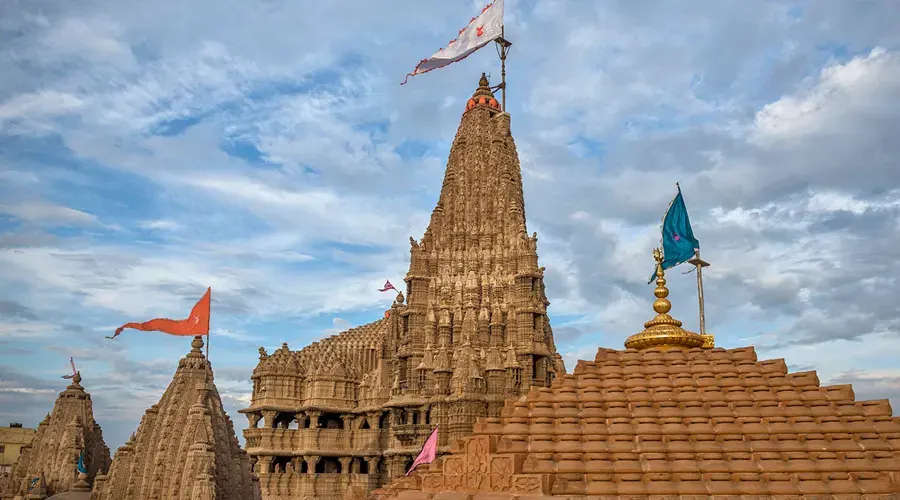Dwarkadhish Temple
The main draw for tourists coming to Dwarka, the Dwarkadhish Temple (Jagat Mandir), is believed to have been established more than 2500 years ago by Lord Krishna’s great-grandson, Vajranabh. The ancient temple has been renovated several times, especially leaving imprints of the 16th and 19th centuries. The temple stands on a small hill accessed by 50-plus steps, with heavily sculptured walls that cocoon the sanctum with the main Krishna idol. Around the complex lie other smaller shrines. The walls have intricately carved mythical characters and legends. The impressive 43 m high spire is topped with a flag made from 52 yards of cloth that flutters in the soft breeze from the Arabian Sea behind the temple. There are two doors (swarg and moksha) for the entry and exit of the temple. A bridge called Sudama Setu (7 am–1 pm, 4–7.30 pm) at the base of the temple takes one across the Gomti creek towards the beach.
Dwarka on the western tip of the Kathiawar Peninsula is clubbed with the holiest sites in India – the Char Dhams which include Badrinath, Puri, and Rameshwaram. It is believed that Lord Krishna arrived here from Braj in Uttar Pradesh to build the city. The temple was established by his grandson. It is at the cusp of the Gomti River and the Arabian Sea, providing a scenic backdrop to the spiritual site. It is said that Dwarka was submerged under the sea six times and what we see now is its seventh avatar. The temple itself has a fascinating legend. The original structure was destroyed by Mahmud Begada in 1472 and subsequently rebuilt in the 15th-16th century. It was also feted by Adi Shankaracharya, the 8th-century Hindu theologian, and philosopher.
The Significance of Dwarkadhish Temple
The significance of Dwarkadhish Temple is that Dwarka is one of the Sapta Puris in India. According to popular belief, the Dwarkadhish Temple stands over the original place of Hari – Graha, the home of Krishna. Mahabharata states that the castle of Lord Krishna was built in Gold.
The Pandavas played and spent their childhood there. This temple is also a part of the famous Pancha Dwaraka Tour.
Archaeologists have unearthed copper coins, boulders, pillars, and pottery samples from the underwater excavations in Dwarka. Hence, they have concluded that a well-established city existed there in the 2nd Millennium.
Also, explorations between 1983 and 1990 show that the city consisted of six sectors. They were extended about a mile from the shore. Offshore investigations have found evidence of stone slabs, ports, and other construction materials dating back to the 15th Century. Hence, it supports the existence of an ancient city at the time of Lord Krishna. Further, the layout of the city mentioned in ancient manuscripts matches that of the city unearthed by The Marine Archaeology Unit of India.
The Dhwajaji – The Mast Flag atop the main Temple is unique and sacred. It is Aadhi Bhoutik in nature. The Dhwaja or the Flag is made of 52 yards of cloth. 52 small flags are woven individually in each yard of cloth. Each Yard symbolizes the entrance to the ancient city of Dwarka.
According to scriptures, 56 administrators ran the administration of Dwarka. Four of them were Lord Krishna, Balram, Pradyuma, and Anirudhji. These 4 are still worshipped in temples that are untouched by the sea. However, the flag acts as a remembrance for the rest of the 52 people. The colors of the Dhwajaji are changed every day.
Kusheshwar Mahadev Temple
On the premises of the Dwarkadhish Temple, a small temple called Kusheshwar Mahadev Temple is present. According to a legend, Kush was a demon who lived in Kushasthali. People prayed to Lord Krishna to save them. So, Lord Krishna fought and crushed the demon. Krishna buried him completely into the ground. Hence, he set up a temple of Lord Mahadev there. The Shiva Linga lies almost 20 feet below the ground.
Dwarka Mutt
The Dwarka Mutt is one of the four mutts established by Sri Adi Shankaracharya. The others are Sringeri, Jagannath Puri, and Jyotirmath. Another name for Dwarka Mutt is Shanti Peeth. It is sacred to dip at the Gomati Ghat opposite the Dwarkadhish Temple. Genuine worship at this temple washes away one’s sins.
The Story of the Origin of Dwarka
Lord Krishna’s uncle Kansa was the ruler of Mathura. His father-in-law, Jarasandha influenced him greatly. Also, Kansa terrorized and tortured the people of Mathura. Due to cruelty towards people, Krishna eventually killed him. When Kansa died, Jarasandha was furious. So, he invaded Mathura several times.
However, he was unsuccessful in annexing it. But the Yadava clan suffered huge losses and Lord Krishna decided to move them elsewhere.
Further, the story of how Krishna formed the city of Dwarka has two versions. One states that Lord Krishna flew on the Garuda and reached the Saurashtra peninsula. However, in the other version, Lord Krishna invoked Vishwakarma (Lord of Construction). He asked him to build a new city.
Vishwakarma said that it is possible to build the city if the Samudra Deva (God of Sea) gives them land. Lord Krishna worshipped the Sea God who eventually gave him 12 Yojanas of land. Consequently, Vishwakarma built the city of Dwarka for Lord Krishna.


Comments (0)